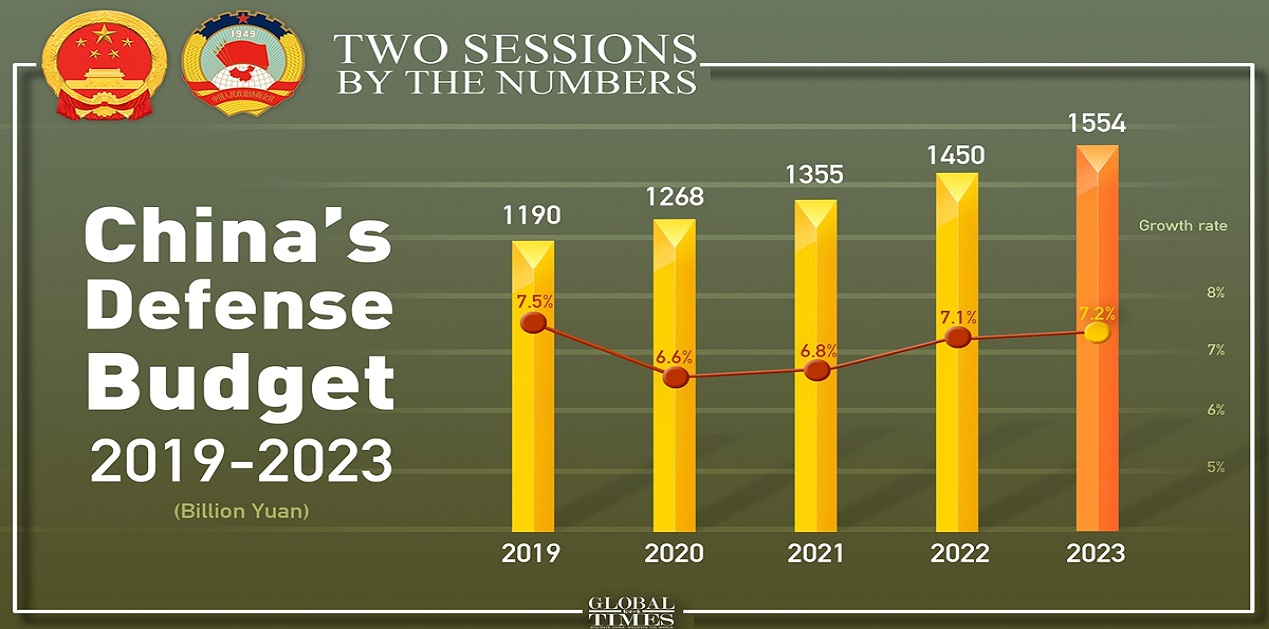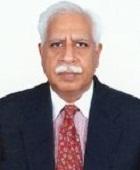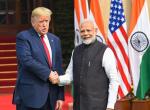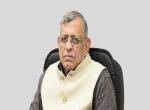The plenary sessions of the Chinese People’s Political Consultative Conference (CPPCC), the top political advisory body, and the National People’s Congress (NPC), China’s version of a parliament, which opened in Beijing’s Great Hall of the People on March 4 and March 5 respectively amid high security provided a fresh thrust to the People’s Liberation Army (PLA). The observations by the NPC deputies and CPPCC delegates give some insight into the mood and thinking of the Chinese authorities. The NPC session (March 5-11) signalled that Xi Jinping had still further consolidated his stature as China’s preeminent leader and more firmly stamped the Chinese Communist Party (CCP)’s imprimatur on the state. Equally importantly, it reaffirmed China’s global leadership ambitions.
As in past years the Chinese leadership ensured that the PLA was adequately provided for. The National Defence budget was officially increased by 7.2 percent, or 1.67 trillion yuan (US$ 231.4 billion) making 2024 the ninth straight year to see a single-digit hike in the country's defence budget. The National Defence budget has doubled since 2013 when Xi Jinping took over. This increase, in spite of China’s slowing GDP growth rate, confirms that China continues to build a modern, technologically-advanced world class army and harbour ambitions to ‘recover’ its so-called ‘lost’ territories. Noticeable too is the fresh thrust towards advanced technology and the emphasis on building the Navy. The focus on advanced and emerging technologies was emphasised by Chinese President Xi Jinping in an “important” speech to PLA and People’s Armed Police (PAP) Deputies and Delegates attending the NPC and CPPCC sessions on March 7. This will mean greater attention to the PLA Strategic Support Force (PLA SSF) and PLA Rocket Force (PLA RF). The presence at the event of Politburo (PB) member and Central Military Commission (CMC) Vice Chairman General Zhang Youxia, PB member and CMC Vice Chairman He Weidong and other CMC members Liu Zhenli and Zhang Shengmin ensures implementation of the instructions.
The PLA SSF is already at the centre of China’s hi-tech military integration and modernisation plans as evident from its organisational structure. Its Aeronautical Support Force (Satellite and Space), Network Systems Department (Cyber and SIGINT) and Aerospace Force (Space launch, Space Tracking, Telemetry and Control (Space TT&C), Space C4ISR, Counter Space and Strategic Intelligence) encompass almost the entire range of emerging technologies. In March 2024, in fact, the SSF sought to recruit majors in computer science, artificial intelligence and big data, and aerospace technologies, from top-tier universities for nearly 500 positions. According to a report published in 2021 by the Centre for Security and Emerging Technology at Georgetown University, U.S., the SSF accounts for more AI-related equipment contracts than any other PLA branch. The South China Morning Post (March 27) disclosed that the SSF held training exercises in February using countermeasures in response to simulated drone attacks and network penetration by “enemies” and that it had earlier conducted exercises involving “electromagnetic confrontation” in an exercise under the Central Theatre Command.
According to Xinhua, on March 7, Chinese President Xi Jinping “emphasised that the strategic capabilities in emerging fields are crucial components of the national strategic system and capabilities, which are related to the high-quality development of China's economy and society, national security, and the initiative of military struggle”. He stressed the need to "promote the efficient integration and two-way stimulation of new productive forces and new combat forces". He emphasised the need to strengthen the sense of mission, deepen reform and innovation, and comprehensively enhance the strategic capabilities in emerging fields. Six PLA deputies from various military sectors presented their suggestions. The issues reflected the PLA’s areas of interest. These were: advancing maritime situational awareness capabilities, enhancing cybersecurity defence capabilities, promoting the application of Artificial Intelligence, strengthening the coordination and management of space resources, standardizing the development of emerging field standards, and innovating the construction and application of unmanned combat forces.
Speaking to the 269 PLA and PAP deputies attending the meeting – of the 281 PLA and PAP deputies 12 were removed on charges of corruption etc. – Xi Jinping focussed on the enhancement of strategic capabilities in emerging fields, the need to grasp the characteristics for developments in emerging fields, efficient integration of new productive forces and new combat forces, and achieving mutual promotion. He highlighted the importance of prioritizing breakthroughs in development and ensuring the implementation of strategies and plans for building strategic capabilities in emerging fields.
Xi Jinping stressed the importance of innovation and said that the development of emerging fields fundamentally relies on technological innovation and application. He advocated enhancing confidence in innovation, promoting independent and original innovation, and fostering a vibrant ecosystem for innovation. Xi Jinping also emphasized the need to prioritize reform in emerging fields as a key aspect for further comprehensively deepening reform. He called for building an innovative ecosystem that is self-reliant, open, integrated, and dynamic, and improving the overall efficiency of developing emerging fields. This, he pointed out, required establishing and improving systems and mechanisms for processing demand, planning coordination, and resource sharing, advancing standardisation, and enhancing the overall benefits of the development of emerging fields.
Additionally, he emphasised accelerating the development of new combat capabilities, deepening reform of the national defence science and technology industry system, optimizing the structure of the national defence science and technology industry, and establishing mechanisms for agile response and rapid transformation of advanced technologies to adapt to the development of emerging fields. Xi Jinping called for updating ideological concepts, boldly innovating and exploring new models of construction and application of new combat forces, and fully liberating and developing new combat capabilities.
Xi Jinping pointedly stressed it is important to "integrate preparation for maritime military warfare, safeguarding of maritime rights and development of the maritime economy". On the side-lines of the NPC session, Yuan Huazhi, Political Commissar of the PLA Navy and NPC Deputy, told the Hong Kong Commercial Daily (March 5) that China will unveil its fourth aircraft carrier soon. He said there is no bottleneck in China's aircraft carrier technologies, and the development is progressing smoothly. The appointment of General Dong Jun, a PLA Navy officer and submariner, as Defence Minister will ensure adequate funds for the Navy.
Xi Jinping also underscored the need to build a network space defence system and enhance safeguards for national network security. Alluding to Civil-Military fusion, he called for strengthening the coordinated implementation of major projects in science and technology, promoting independent and original innovation, and fostering a vibrant ecosystem for innovation. Stating that State owned Enterprises (SoEs) are playing a key role, Zhang Yuzhuo, Chairman of the State-owned Assets Supervision and Administration Commission (SASAC) of the State Council, disclosed (March 5) that investment by central SOEs in strategic emerging industries increased 32.1 percent year on year in 2023. He said the SASAC's goal envisaged income derived from strategic emerging industries by central SOEs as accounting for 35 percent of their total income by 2025. He said it is important to increase investment in industries "especially in brain-like intelligence, quantum information and controlled nuclear fusion."
The leadership of the State Council’s State-owned Assets Supervision and Administration Commission (SASAC), which controls the central State-owned Enterprises (SoEs), moved rapidly and met in Beijing on March 29. It called for reforms to enable SoEs to invest more on innovative and fundamental technologies over a medium-to-long-term rather than short-term. Consequent to the economic slowdown and US-led restrictions on critical technologies, Beijing is relying increasingly on central SOEs to drive technological innovation and industrial upgrading. In 2023, the combined investments of central SOEs in strategic emerging industries (SEI) surged by 45.3% year-on-year, reaching RMB 2.18 trillion.
Important was the attention given by Xi Jinping to strengthening the armed forces for multi-dimensional warfare (land, air, cyber, space and sea) by using advanced technology and to enhance the PLA Navy’s maritime capabilities.
Indicating that the military was studying the new direction, soon after the NPC session concluded the Guangming Daily (March 24) published two important articles on enhancing strategic capabilities and AI. The articles were authored by members of the Party Innovation Theory Research Centre, National University of Defence Technology, and faculty members of the Army Engineering University and Army Command College respectively.
The article by the Party Innovation Theory Research Centre, National University of Defence Technology, said “accelerating defence technological innovation is an urgent need to win military competition and maintain the initiative in warfare”. It listed the following steps as necessary to precisely grasp the pulse of the future battlefield in emerging fields: -
- New concepts, new technologies, and new achievements emerge frequently in fields such as artificial intelligence, cyberspace, deep sea, and outer space, and generate new productive forces and also accelerate the generation of new combat capabilities. It is, therefore, necessary to target the forefront of technological development in emerging fields.
- It is imperative to scientifically distinguish which are the new domains and qualities that will dominate the future battlefield, which are the long-term forces that can still influence the direction of modern warfare in traditional space, and which are the backward capacities that need to be eliminated.
- We should comprehensively develop strategies for technological development in various fields, seize opportunities and advance with the times, adhere to the integrated development of mechanization, informatization, and intelligentization, and promote the overall improvement of technological innovation in all fields. The vitality of military-civilian collaboration in emerging fields must be exploited.
- Strong grassroots talent teams should be built to upgrade combat effectiveness and achieve the "best solution" to defeat the enemy.
- Technological innovation in emerging fields should focus on new quality productivity and high-quality development, focus on the generation of new quality combat power and new types of combat forces. It should attract cross-industry, cross-disciplinary, and cross-regional research and development. Data and resources should be collected and integrated across industries, disciplines, and regions, to provide support for innovation.
- Based on the generation of new quality combat power, we should improve cooperation between industry, academia, and research institutes, integrate resources from enterprises, universities, research institutes, and other parties, strengthen multi-party cooperation and joint research and development, form a strong synergy for tackling key core technologies, and achieve common promotion of military and civilian technological innovation resources, and jointly tackle key core technology challenges. This will ensure that technological innovation in emerging fields is shared between the military and civilian sectors, projects are jointly developed by the military and civilians, and the outcomes of technological innovation are shared between the military and civilians. It will accelerate the transformation of technological achievements in emerging fields into new quality combat capabilities.
- Accelerating the enhancement of new quality combat capabilities relies on technological innovation and technological empowerment. Whether it is "future wars", "hybrid wars" or "high-end wars" beyond conceptual distinctions, they share the common characteristic of being technological wars. It is necessary to use new technologies and new concepts to transform and enhance the efficiency of traditional achievements.
- The tremendous potential of new quality combat capabilities must be transformed into actual combat capabilities through practical training. Emerging fields are often unfamiliar territories for many combatants, and new technological achievements must transition from the "laboratory" to the "battlefield" through countless "experimental fields" "training grounds", and "timelines".
- To expedite the transformation of technological innovations into actual combat capabilities, it is necessary to reduce the time for transforming from “old” to "new" capabilities. This includes studying operational issues in emerging fields, innovating operational concepts and tactics, promoting the weaponization of emerging technological achievements, enhancing technological cognition, innovation, training by weapon development personnel of various levels of combatants, and continuously achieving breakthroughs in combat capability quality.
The second article by the Professors at the Army Engineering University, and Army Command College focussed on AI and the likely changes in the mode of warfare. Interestingly, they argued that “in future intelligent warfare, the core functionality of combat force systems will not undergo fundamental changes” and the essential elements of personnel, weaponry, and organization for carrying out combat missions will still be indispensable. However, they will undergo reshaping with the support of artificial intelligence technology. The article said in “intelligent warfare” the focus will shift from widespread personnel casualties to effective control over enemy combat centres and even combat systems. Combat personnel will engage less in direct confrontations as "warriors" and increasingly serve as "strategists" monitoring and controlling combat actions, with closer connections to the entire warfare system. In future wars, simulated "human-like" robots, which surpass humans in certain functional areas, will be extensively deployed on the battlefield and become the primary combat entities tasked with various missions.
In “intelligent warfare”, as the intensity and breadth of confrontations between systems continue to increase, the focus on forming open, integrated, and flexible combat systems is at the core of the construction of the intelligent warfare organizational structure. The integration of military forces is gradually becoming the trend. Intelligent combat force systems are usually constructed based on mission requirements, using intelligent algorithms to precisely calculate the composition of combat force units and optimize their organization through the precise allocation of modular forces, forming specialized and efficient systematic combat forces. This requires combining the requirements of intelligent selection for force modularization, and refining and quantifying the functions of existing functional module forces so that they form corresponding functional "menus" in terms of attack capability, protection capability, mobility, autonomy, and integration capability, ensuring that they can be accurately read, measured, and called upon during wartime.
Within days of the conclusion of the second session of the 14th NPC, Chinese leaders, scientific establishments, government and provincial government entities began discussing ways to implement Chinese President Xi Jinping’s directions of March 7. In addition to the huge amounts already invested in science and technology, especially in AI and emerging technologies, China has now begun harnessing the financial and other resources of the mammoth central State-owned Enterprises (SoEs). With the Civil-Military Fusion programme in force there is now no difference between research for civil or military use or in the application of new emerging technologies.
(The paper is the author’s individual scholastic articulation. The author certifies that the article/paper is original in content, unpublished and it has not been submitted for publication/web upload elsewhere, and that the facts and figures quoted are duly referenced, as needed, and are believed to be correct). (The paper does not necessarily represent the organisational stance... More >>
Image Source: https://www.globaltimes.cn/Portals/0/attachment/2023/2023-03-05/84e9b585-bb35-4c2b-801c-5da1e6a37959.jpeg











Post new comment